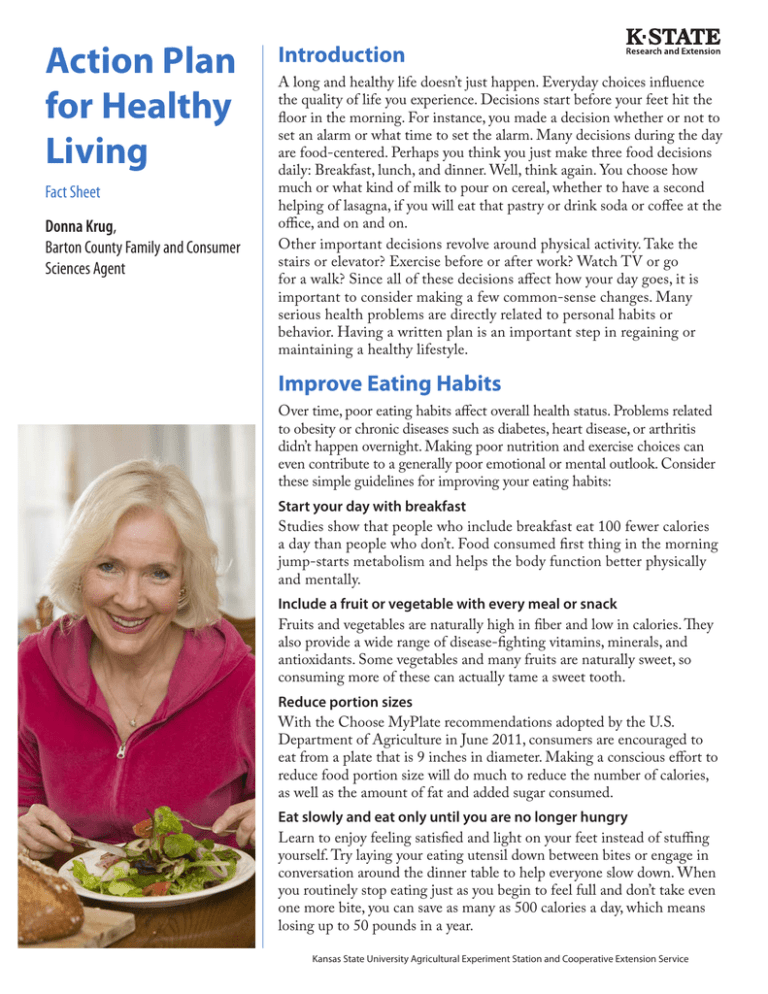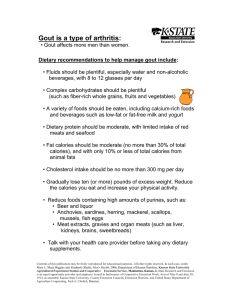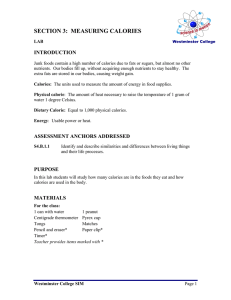
Action Plan
for Healthy
Living
Fact Sheet
Donna Krug,
Barton County Family and Consumer
Sciences Agent
Introduction
A long and healthy life doesn’t just happen. Everyday choices influence
the quality of life you experience. Decisions start before your feet hit the
floor in the morning. For instance, you made a decision whether or not to
set an alarm or what time to set the alarm. Many decisions during the day
are food-centered. Perhaps you think you just make three food decisions
daily: Breakfast, lunch, and dinner. Well, think again. You choose how
much or what kind of milk to pour on cereal, whether to have a second
helping of lasagna, if you will eat that pastry or drink soda or coffee at the
office, and on and on.
Other important decisions revolve around physical activity. Take the
stairs or elevator? Exercise before or after work? Watch TV or go
for a walk? Since all of these decisions affect how your day goes, it is
important to consider making a few common-sense changes. Many
serious health problems are directly related to personal habits or
behavior. Having a written plan is an important step in regaining or
maintaining a healthy lifestyle.
Improve Eating Habits
Over time, poor eating habits affect overall health status. Problems related
to obesity or chronic diseases such as diabetes, heart disease, or arthritis
didn’t happen overnight. Making poor nutrition and exercise choices can
even contribute to a generally poor emotional or mental outlook. Consider
these simple guidelines for improving your eating habits:
Start your day with breakfast
Studies show that people who include breakfast eat 100 fewer calories
a day than people who don’t. Food consumed first thing in the morning
jump-starts metabolism and helps the body function better physically
and mentally.
Include a fruit or vegetable with every meal or snack
Fruits and vegetables are naturally high in fiber and low in calories. They
also provide a wide range of disease-fighting vitamins, minerals, and
antioxidants. Some vegetables and many fruits are naturally sweet, so
consuming more of these can actually tame a sweet tooth.
Reduce portion sizes
With the Choose MyPlate recommendations adopted by the U.S.
Department of Agriculture in June 2011, consumers are encouraged to
eat from a plate that is 9 inches in diameter. Making a conscious effort to
reduce food portion size will do much to reduce the number of calories,
as well as the amount of fat and added sugar consumed.
Eat slowly and eat only until you are no longer hungry
Learn to enjoy feeling satisfied and light on your feet instead of stuffing
yourself. Try laying your eating utensil down between bites or engage in
conversation around the dinner table to help everyone slow down. When
you routinely stop eating just as you begin to feel full and don’t take even
one more bite, you can save as many as 500 calories a day, which means
losing up to 50 pounds in a year.
Kansas State University Agricultural Experiment Station and Cooperative Extension Service
Visit www.choosemyplate.gov to learn
more about a balanced diet.
Choose to eat more nutrient-dense foods
Foods that have low nutrient density supply calories but little or no
amounts of vitamins and minerals; therefore, they are given the label
“empty calories.” On the other hand, nutrient-rich or dense foods have
lots of vitamins and minerals compared to the number of calories they
provide. A practical example of this is to compare the nutritional value of
a whole raw apple (52 calories) to a slice of dutch apple pie (350 calories).
Not only is there a dramatic difference in calories in these two food
choices, but the amount of sugar and fat found in a slice of pie is more
than an average person needs in a meal.
Eat whole foods instead of highly processed foods
This recommendation goes hand in hand with the last one. Highly
processed foods have added colorings, chemical flavor enhancers, and
preservatives you cannot pronounce. Whole foods mean less sugar, fat,
sodium, and chemicals, and they provide more fiber and natural nutrients.
Get Moving
Along with choosing to consume healthier food, many people can achieve
a healthy lifestyle by increasing physical activity. Start by investing in
a good pair of walking shoes and walking around your neighborhood
or indoor exercise facility. Another habit that will increase success is
scheduling time for physical activity during your day. Here are four
simple guidelines to get your heart rate up and your muscles stretched:
Start slow
If you have been inactive for a period of time, make sure you do not
overdo your first workout. Sore muscles or shortness of breath translate to
not wanting to continue. As with any exercise program, check with your
health-care provider first.
Find a buddy
Since it takes approximately six weeks of repetition to turn something into
a habit, you will want to find a friend who is as committed to exercise as
you are. Agree to hold each other accountable for increasing your level of
physical activity. Then you just need to hold up your end of the bargain.
Do regular physical exercise
This is the first step to help offset the declining metabolic rate that occurs
as we age. This decline is 2 percent per decade after age 30, or about 100
fewer calories burned each day by age 50. If a person does not eat less or
exercise more, this could cause a yearly weight gain of 10 pounds. Another
part of aging is a change in body composition — more fat and less muscle.
People who exercise regularly have a more favorable body composition,
with a lower proportion of body fat. People who exercise regularly have
greater bone density than those who do not. To be most helpful, regular
exercise should be started early in life to help maintain bone density.
When Eating and Exercising Aren’t Enough
When healthy food choices and the addition of regular physical activity do
not bring about the healthy lifestyle you were hoping for, perhaps it is time
to consider other factors that influence health. According to the University
2
of Florida IFAS Extension publication, Healthstyle: A Self-Test, it is
estimated that 7 of the 10 leading causes of death could be reduced through
common-sense changes in lifestyle. Consider these six “S” strategies for
achieving a healthy life:
Stress management
Stress is a normal part of living, and the causes of it can be good or bad.
When stress becomes distress people often show unhealthy responses,
such as driving too fast, prolonged anger, worry or fear, or drinking too
much. Learn to find ways that reduce stress in your life. Things like deep
breathing, physical activity, and positive self-talk may be effective.
Simplify
Hectic schedules may not allow for adequate down time, but it is
important to find some quiet time each day with no demands. Another
way to simplify your life is to de-clutter your living space. Refer to the
K-State Research and Extension publication MF2879 Cut the Clutter and
Get Organized for some tips.
Safety first
Whether you are walking, riding a bicycle, or driving in a car there are
choices that can improve safety. Wearing a seat belt when in a vehicle,
a helmet when cycling, and leaving electronic devices turned off while
driving to keep distractions to a minimum would be good decisions.
Stop smoking and limit alcohol consumption
Both smoking and excessive drinking are real issues that pose great health
risks. There are community-based programs that can help people who are
serious about eliminating these unhealthy habits.
Sleep well
Making simple changes in routine, environment, diet, and other factors
can help you achieve adequate sleep. Sleep disorders are common, and
some are serious, but most can be treated. An excellent resource to learn
more about sleep is the K-State Research and Extension publication
MF2830, Sleep: Want It, Need It, Get It.
Surround yourself with positive people
When someone is feeling down, one of the best strategies is to spend
time with positive, upbeat people. Laughter, encouragement, and positive
thoughts can effectively help reverse negative thoughts.
Develop an Action Plan
You have 15 strategies at your fingertips to help you achieve a healthy
life. In order to be successful, consider putting your plans in writing by
developing an action plan. The most important part of an action plan
is to choose something you want to do. Next it needs to be something
reasonable, such as something you can expect to be able to accomplish in
a week or a month. A true action plan is behavior specific. Losing weight
is not a behavior; not eating after dinner is. An action plan answers these
questions: What? How much? When? How often?
The final piece of a successful action plan is to assess the confidence level
that you will fulfill the contract. On a scale of 1 to 10 where 1 represents
3
Reviewers
Sharolyn Flaming Jackson, Family and
Consumer Sciences Specialist, K-State
Research and Extension – Northeast Area
Pat Gerhardt, Family and Consumer Sciences
Agent, K-State Research and Extension –
River Valley District
little confidence and 10 represents total confidence, your plan should rank
at least a 7. The following form is easy to complete and post where you will
see it daily.
Conclusion
Many serious health problems are directly related to personal habits or
behavior. The risk factors that can lead to these problems are of little
concern to many people. They have the attitude, “I feel fine – why worry
about a healthier lifestyle?” The medical system was built around caring
for the sick instead of keeping people well. Achieving a healthy lifestyle
takes knowledge, effort, and determination. No one can do it for you. You
have tools at your fingertips to help you achieve a healthier life. Now is
the time to build healthy habits into your daily life. Soon they will come
naturally. Good luck with that endeavor.
My Action Plan
My Progress
Check off
This week I will _______________________ (what)
____________________________________ (how much)
____________________________________ (when)
____________________________________ (how many)
How confident are you? ______
(0 = not at all confident; 10 = total confident)
Comments
Monday
Tuesday
Wednesday
Thursday
Friday
Saturday
Sunday
Brand names appearing in this publication are for product identification purposes only.
No endorsement is intended, nor is criticism implied of similar products not mentioned.
Publications from Kansas State University are available at: www.ksre.ksu.edu
Publications are reviewed or revised annually by appropriate faculty to reflect current research and practice.
Date shown is that of publication or last revision.
Contents of this publication may be freely reproduced for educational purposes. All other rights reserved. In each case,
credit Donna Krug, Action Plan for Healthy Living, Fact Sheet, Kansas State University, July 2012.
Kansas State University Agricultural Experiment Station and Cooperative Extension Service
MF3053
July 2012
K-State Research and Extension is an equal opportunity provider and employer. Issued in furtherance of Cooperative Extension Work, Acts of May 8 and June 30, 1914,
as amended. Kansas State University, County Extension Councils, Extension Districts, and United States Department of Agriculture Cooperating, Gary Pierzynski, Interim
Director.




